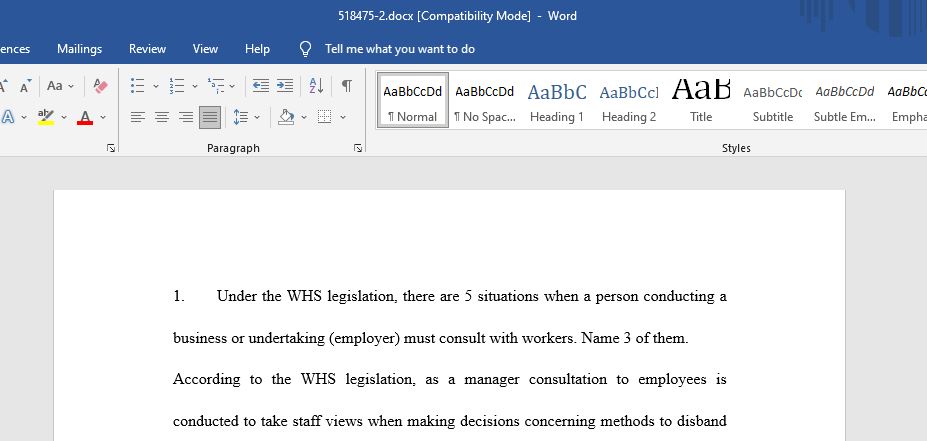Explain the situations when a person conducting a business or undertaking (employer) must consult with workers.
Questions
1. Under the WHS legislation there are 5 situations when a person conducting a business or undertaking (employer) must consult with workers. Name 3 of them.
2. List 4 ways of providing staff with workplace health and safety information.
3. An emergency evacuation plan is one example of a WHS procedure which helps to keep people safe. List 4 others relevant to your industry.
4. List 2 methods of monitoring that staff are following WHS procedures.
5. List 3 types of document that would act as evidence of your company’s compliance with WHS laws.
6. List 4 possible steps you could take if you observed a staff member not complying with your company’s WHS practices, or a hazard control measure was not working properly.
7. List 5 WHS issues or potential hazards you need to monitor in your department/industry on a daily basis.
8. List 3 matters you might discuss as part of making consultation arrangements
9. Name 3 methods you can use to provide staff members the opportunity to contribute their views on WHS issues.
10. If you cannot resolve a staff members WHS issue or control a hazard yourself, name 3 people you might refer the issue to in order to find a resolution.
11. Once a staff members WHS issues has been resolved, why is it important to communicate the result back the staff member who raised it?
12. List 4 times/events you would work through risk management/hazard controls steps according to the “How to manage work health and safety risks” Code of Practice by Safe Work Australia.
13. List 4 different types of WHS training methods.
14. Give 2 examples of when you must provide WHS training to your staff.
15. Give 4 examples of training you might organise with a specialist WHS training provider.
16. Give 3 reasons you should monitor the effectiveness of training programs?
17. Where should MSDS be kept?
18. List 3 pieces of information you can find on an MSDS.
19. What information does filling out a risk assessment give you?
20. List 4 pieces of information that should be recorded as a training record for a staff member who has undertaken WHS training.
21. How can you minimise the environmental impacts of storing documents and files?
22. Under the WHS legislation, what is an employer’s duty of care in relation to providing a safe workplace?
23. If a business chooses to have direct, regular contact between employer and employees instead of appointing a WHS Committee or appoint WHS Representatives, have they failed to meet the requirements of the WHS act? Why/Why not?
24. If a WHS Committee raises a WHS issue with an employer, and the employer does not consider the issue in a timely fashion, has the employer failed to meet their legal requirements? Why/Why not?
25. What is the role of a WHS Committee?
26. List 2 penalties a judge may impose on you if you fail to meet your duties under the WHS act.
Answer preview:
Words: 1,724

